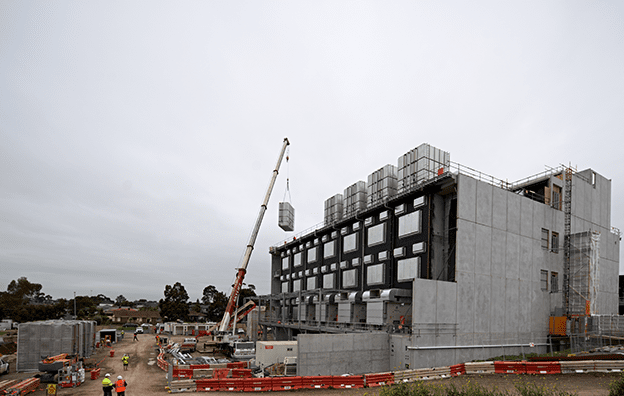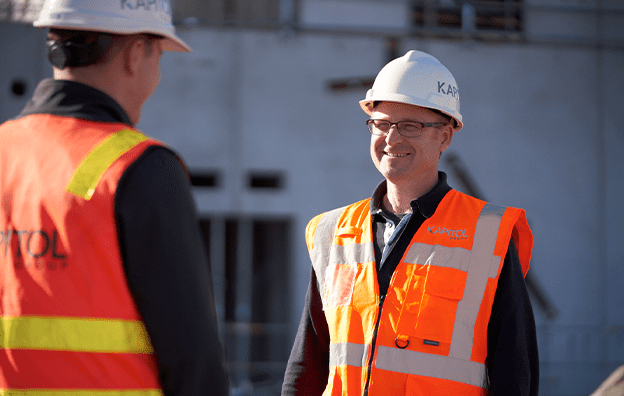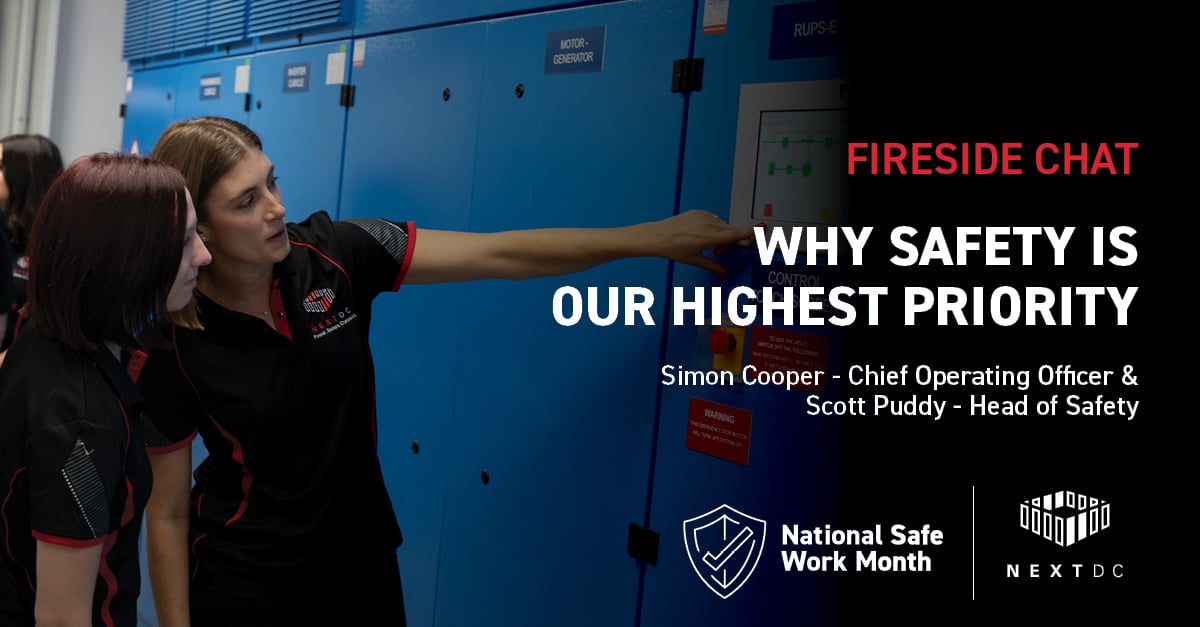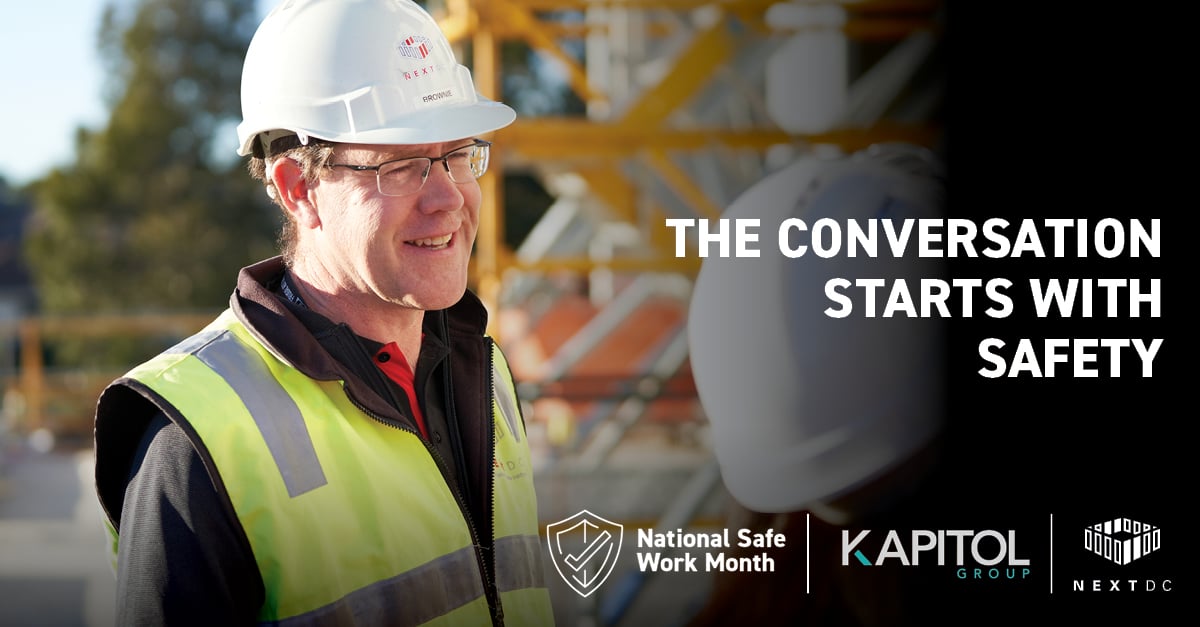At NEXTDC, safety is our highest priority. In this two-part safety series, we spoke to the M2 Project team from NEXTDC (Simon Brown) and Kapitol Group (Tim Trimble) to learn more about how safety has been addressed on-site.
In Part 1 of our safety deep dive on the M2 construction site, we discussed alignment of safety strategies. In Part 2, we look closely at the M2 expansion project, and what’s required to keep teams safe and the project progressing under the shadow of a global health crisis.

Dealing with a global health crisis
What steps were taken on-site to keep teams safe and how did the project change when COVID first reared its head in February 2020?
Simon Brown, Project Manager, NEXTDC (SB): We had never dealt with a pandemic before, so we were in unfamiliar territory. Our first step was to split into teams, i.e. a red team/blue team scenario across both organisations. If someone tested positive and forced close contacts into isolation, this ensured the project wouldn’t be in jeopardy. We kept teams separate, including the top management and the workers on site. They had separate lunch sheds, separate toilets and in some cases, separate plant, and tools.
We also moved very quickly to adopt a COVID plan to keep our people safe. We had a plan in place within days of case numbers starting to rise in Australia, over a week ahead of any mandates put out by health authorities. Traditionally, we would have offices on site and a lot of people – engineers, safety managers, procurement people etc. – but that changed immediately.
We then created social distancing procedures including additional cleaners and more frequent cleaning schedules as well as sanitation stations and strict recording of cleaning cadence.
It was a shock to the system, but it ran smoothly. Along the way, both organisations were sharing notes and working together to keep the site safe and compliant.
Tim Trimble, Senior Project Manager, Kapitol Group (TT): From Kapitol Group’s side, we started vetting people before they came on site with questionnaires about symptoms or close contacts with anybody who was positive or even unwell via our touchless sign-in on our safety software HammerTech. We mapped where our contractors went on site and implemented new rules prohibiting tool sharing and ramped up cleaning of plant such as scissor lifts after each use. With assistance from HammerTech we also created QR codes every day so that trades could simply use their phones to show which tools they had used.
We also put into place a rigorous communications schedule to educate teams about the virus, our obligations, responses and emphasising how important COVID-safe vigilance was. This communications exercise extended to every person granted access to the site. They had to undergo a COVID induction in addition to the usual site induction and we supported sub-contractors to educate their teams.
Taking site safety into uncharted territories
What changed on-site when Stage 4 restrictions were mandated across Melbourne?
SB: The first big impact was issuing work permits and reducing the number of people we had on the site to 25% of the normal work force. That saw the numbers on site reduced from ~200 to 50.
There was no carpooling allowed, we had to police that, and of course we introduced temperature testing for every person on site. We again ramped up the touchless systems and there was a lot of work done by Kapitol to enhance the features on the HammerTech app.
We also further extended the cleaning regimen and installed many more sanitation stations. They were everywhere and teams were encouraged to use them before and after they used any physical item on site. More toilets and sheds were added to the site to ensure that we could keep people socially distanced.
TT: We had already introduced COVID mapping but that was taken to another level so we could trace people effectively if there was a confirmed infection for one of our team. Previously we had been mapping where and when they had been working on the site whereas now we were getting much more granular including recording which toilets they used as well as which sheds, tables and even chairs they sat in during breaks.
For transient people such as concreters and crane drivers – that might be working on multiple sites in a week – we designated that they were only able to go to three sites per week. They were also mandated to use separate lunch sheds and amenities, so they were not mixing with our site specific teams.
Because we were limited to having only 50 people on the site at a time, we had to conduct meetings every day to ensure we had the right people on site each day to attack critical path to completion. There was a lot of deckchair shuffling in consultation with NEXTDC to make sure we were meeting the schedule that NEXTDC had to provision their customers.

Pandemic accelerates digital transformation
What lessons learned from the COVID response will endure in future safety practices?
SB: The biggest revelation was that not everybody has to be on site all the time. There are obviously times when some people have to be on site to complete critical assessment and management tasks but there are a lot of tasks that can be completed via videoconferencing and file sharing. We have the systems to keep people who don’t need to be there productive without being on the site.
I would also say that the enhanced and touchless systems and interactions we will retain moving forward wherever possible.
Another benefit we are seeing is in extending the use of prefabricated equipment. This has been accelerating for many years now, but it too has taken a quantum leap during this pandemic as it represents a great opportunity to limit the number of people you need on a site.
There are enormous gains in safety and reduced complexity around managing our construction sites with less people on site and less people working at heights.
Video conferencing is also a keeper. There are so many efficiencies and work/life balance benefits to be gained here by not having people travel as much. There is a lot that can be done remotely with regards to site safety and other construction compliance.
IT industry analysts claim COVID has advanced digital transformation by up to five years and that is certainly the case when it comes to our construction sites.
TT: That’s so true. By enabling as much of a touch-free environment as possible is helping to make our systems a lot more streamlined, efficient and even environmentally sustainable as we have removed hardcopy records.
Importantly, we have learned a lot about how QR-codes, mobile phones and other digital technologies can be applied to the way we work, communicate, comply with regulations, and keep people safe. There is an enormous amount of IT development going on to take advantage of what we have introduced so far, and we see a big window for innovation and continual transformation into the future.
We consider ourselves early adopters using cloud-based software where possible for business solutions, health and safety being a significant one. Safety concerns around the pandemic have seen great changes and initiatives made around how we not only keep our people safe, but also around tracking activity on the site and that creates significant opportunities to improve productivity and cost efficiencies moving forward.
If you would like to understand how NEXTDC can support your critical IT operations and ensure you and your teams' safety is continually top of mind, reach out and speak with a specialist.


